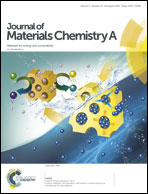Multifunctional hierarchical 3-D ZnO superstructures directly grown over FTO glass substrates: enhanced photovoltaic and selective sensing applications†
Abstract
Ammonia has been extensively utilized in many applications such as agrochemicals, pharmaceuticals, organic dyes, synthetic fibres, and it can diffuse into the atmosphere and cause severe effects on human health as well as the environment. Ammonium nitrate is usually found in many explosives and they release trace amounts of ammonia upon decomposition, the monitoring of which is very crucial in order to prevent lethal accidents. It is therefore necessary to develop a highly-sensitive room-temperature-efficient NH3 gas sensor. Sensing devices that rely on electron transport often suffer from the drawback of higher ohmic contact between the active materials and the collecting electrodes, which are transparent conducting oxides in most cases. Designing such systems is important, especially when the vapor pressure of the compounds yield very low concentrations of sensing elements. Herein, we report the in situ growth of hierarchical three-dimensional zinc oxide superstructures over a conductive glass substrate, i.e., fluorine-doped tin oxide, under a controlled hydrothermal route for low ohmic contact, allowing efficient charge injection. An anionic polysaccharide “k-carrageenan” was employed for assisting the heteroepitaxial aggregated growth of the 1-D nanocrystals. We have successfully demonstrated the applications of the as-characterized multifunctional 3-D ZnO hierarchical structures in photovoltaic and selective chemical vapor sensing. A significant enrichment (∼33%) in power conversion efficiency (η) for the hierarchical 3-D ZnO superstructure-based photovoltaic device, as compared to the 1-D ZnO nanowires, was observed, mainly due to the larger surface to volume ratio for sensitizer loading, better light-scattering effect, better charge separation and collection. Two terminal sensor devices displayed high sensitivity and selectivity for NH3 vapors with the limit of detection value of ∼5 (±3%) parts per billion (ppb) for three dimensional ZnO hierarchical superstructures and ∼17 (±3%) ppb for 1-D ZnO NWs, which is very small as compared to the maximum permissible limit, i.e., 25 parts per million (ppm). Selectivity, recyclability, response/recovery time and sensitivity toward primary, secondary and tertiary amines have been studied to understand the probable mechanism for the high sensing ability of the hierarchical superstructures.



 Please wait while we load your content...
Please wait while we load your content...